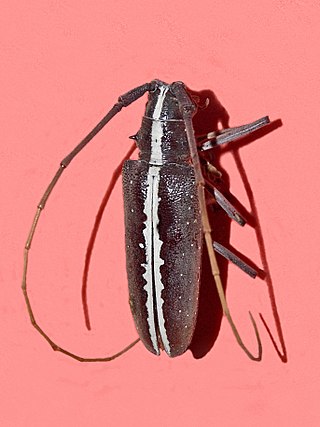
Taeniotes is a genus of flat-faced longhorns beetles in the subfamily Lamiinae of the family Cerambycidae.

Taeniotes scalatus is a species of flat-faced longhorn beetle in the subfamily Lamiinae of the family Cerambycidae.
Crossotus subocellatus is a species of beetle in the family Cerambycidae. It was described by Fairmaire in 1886. It is known from Djibouti, Algeria, Chad, Senegal, Eritrea, Kenya, Egypt, Libya, Mali, Mauritania, Saudi Arabia, Ethiopia, Morocco, Oman, Niger, Nigeria, Somalia, Tunisia, Sudan, and the Western Sahara. It feeds on Acacia tortilis.

Monochamus sargi is a species of beetle in the family Cerambycidae. It was described by Henry Walter Bates in 1885. It is known from Mexico and Guatemala.

Hammatoderus confusor is a species of beetle in the family Cerambycidae. It was described by Dillon and Dillon in 1941. Its Geographical distribution is Brazil, Peru, Bolivia, Paraguay, Colombia and Argentina (Misiones).
Taeniotes boliviensis is a species of beetle in the family Cerambycidae. It was described by Dillon and Dillon in 1941. It is known from Argentina, Ecuador and Bolivia.
Taeniotes dentatus is a species of beetle in the family Cerambycidae. It was described by Dillon and Dillon in 1941. It is known from Ecuador and Colombia.
Taeniotes iridescens is a species of beetle in the family Cerambycidae. It was described by Dillon and Dillon in 1941. It is known from Costa Rica, Colombia, Brazil, and Panama.

Taeniotes amazonum is a species of beetle in the family Cerambycidae. It was described by James Thomson in 1857. It is known from Bolivia, Argentina, and Brazil, and it has been introduced into Azores.
Taeniotes batesi is a species of beetle in the family Cerambycidae. It was described by James Thomson in 1879. It is known from Colombia.
Taeniotes cayennensis is a species of beetle in the family Cerambycidae. It was described by James Thomson in 1859. It is known from French Guiana and Brazil.
Taeniotes leucogrammus is a species of beetle in the family Cerambycidae. It was described by James Thomson in 1865.

Taeniotes luciani is a species of beetle in the family Cerambycidae. It was described by James Thomson in 1859. It is known from Colombia, Mexico, Honduras, Belize, Guatemala, Costa Rica and Panama.
Taeniotes marmoratus is a species of beetle in the family Cerambycidae. It was described by James Thomson in 1865. It is known from Ecuador.
Taeniotes affinis is a species of beetle in the family Cerambycidae. It was described by Stephan von Breuning in 1935. It is known from Peru and Ecuador.
Taeniotes parafarinosus is a species of beetle in the family Cerambycidae. It was described by Olivier in 1790. It is known from Peru, Brazil, Costa Rica, Panama, French Guiana, Bolivia, Guyana, and Suriname. It has also been introduced into Guadeloupe.
Taeniotes peruanus is a species of beetle in the family Cerambycidae. It was described by Stephan von Breuning in 1971. It is known from Peru.

Taeniotes naevius is a species of beetle in the family Cerambycidae. It was described by Henry Walter Bates in 1872. It is known from Ecuador, Colombia, and Peru.

Taeniotes farinosus is a species of beetle in the family Cerambycidae. It was described by Carl Linnaeus in 1758, originally under the genus Cerambyx.
Taeniotes simplex is a species of beetle in the family Cerambycidae. It was described by Charles Joseph Gahan in 1888. It is known from the Galápagos Islands and Costa Rica.







